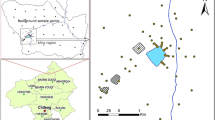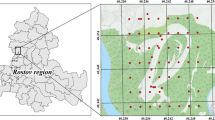Abstract
This study investigates the contents of lead, zinc, and cadmium in 109 near-surface soil samples collected around the abandoned mine of Fedj Lahdoum, northern Tunisia, to assess the risk of pollution they generate. The study involved some analytical procedures such as pH measurements, X-ray diffraction techniques, sequential fractionation, and geostatistical mapping using the ordinary Kriging techniques. The sequential fractionation revealed that the bioavailability of Pb, Zn, and Cd follows the orders F5 > F3 » F4 > F2 » F1, F5 > F3 » F4 » F2 > F1 and F5 > F2 » F4 > F1, respectively; their associations with organic matter and residual sulfides (F4) are relatively low. However, their high cumulated contents are dominantly associated with the residual (F5) and reducible (F3) fractions. The geostatistical mapping was endeavored to predict the spatial distribution of the studied heavy metals at unsampled sites and to produce a cumulated risk map of soil pollution. The latter is discussed with emphasis of the main factors responsible for the scattering of the pollution as much as the landscape conditions, the chemical composition of the mine tailings, the surface drainage of meteoric water and the wind. This study provides insight into the delineation of the spatial spreading of Pb, Zn, and Cd around the abandoned mine Fedj Lahdoum and their surrounding urban areas. It reveals that the mine infrastructure areas encompassing both extraction and processing and tailing deposition areas are the main sources of contamination. And the landscape conditions together with the surface drainage of meteoric water and the wind are the main factors responsible for the scattering of the pollution.











Similar content being viewed by others
References
Abollino O, Aceto M, Malandrino M, Mentasti E, Sarzanini C, Barberis R (2002) Distribution and mobility of metals in contaminated sites, investigation of pollutant profiles. Environ Pollut 119(2):177–193
Adriano DC (2001) Bioavailability of trace metals. In: Trace elements in terrestrial environments. Springer, New York, pp 61–89
AFNOR N 94–048 (1996) Soils: recognition and testing-determination of carbonate: calcimeter method
Ahumada I, Mendoza J, Ascar L (1999) Sequential extraction of heavy metals in soils irrigated with wastewater. Commun Soil Sci Plant Anal 30(9–10):1507–1519
Algan O, Balkis N, Namikcagatay M, Sari E (2004) The sources of metal contents in the shelf sediments from the Marmara Sea, Turkey. Environ Geol 46(6–7):932–950
Alloway BJ (1995) In: Alloway BJ (ed) Heavy metals in soils. Blackie Academic and Professional, p 308
Amini M, Afyuni M, Khademi H, Abbaspour KC, Schulin R (2005) Mapping risk of cadmium and lead contamination to human health in soils of Central Iran. Sci Total Environ 347:64–77
Amlinger F, Favoino E, Pollak M, Peyr S, Centemero M, Caima V (2004) Heavy metals and organic compounds from wastes used as organic fertilisers. Study on behalf of the European Commission, Directorate-General Environment, ENV.A,2
Atkinson PM, Lloyd CD (2014) Geostatistical models and spatial interpolation. In: Handbook of Regional Science, pp 1461–1476
Babbou-Abdelmalak C, Sebei A, Chaabani F (2011) Incurred environmental risks and potential contamination sources in an abandoned mine site. Afr J Environ Sci Technol 5:11,894–11,915
Bhattacharya A, Routh J, Jacks G, Bhattacharya P, Mörth M (2006) Environmental assessment of abandoned mine tailings in Adak, Västerbotten district (northern Sweden). Appl Geochem 21(10):1760–1780
Blanchard C (2000) Caractérisation de la mobilisation potentille des polluants inorganiques dans les sols pollués [Characterization of the potential mobilization of inorganic pollutants in polluted soils]. Dissertation, INSA Lyon
Bouhlel S (1993) Gîtologie, minéralogie et essai de modélisation des minéralisations à F-Ba-Sr-Pb-Zn associés aux carbonates (Jurassique et Crétacé) et aux diapirs triasiques : gisement de Stah, Kohl, Zriba, Guebli, Boujaber et Fedj Lahdoum (Tunisie septentrionale) [Gitology, mineralogy and attempt of modeling of F-Ba-Sr-Pb-Zn mineralization associated with (Jurassic and Cretaceous) carbonates and Triassic diapirs: Stah, Kohl, Zriba, Guebli, Boujaber and Fedj Lahdoum deposits (Northern Tunisia)]. Dissertation, University of Tunis El Manar
Boussen S, Sebei A, Soubrand-Colin M, Bril H, Chaabani F, Adeljaouad S (2010) Mobilization of lead-zinc rich particles from mine tailings in northern Tunisia by aeolian and run-off processes. Bulletin de la Société Géologique de France 181:5459–5471
Bril H, Floc’h J.P (2001) Le devenir des métaux provenant des anciennes mines : l’exemple du massif central français [the fate of metals from old mines; the example of the French Massif Central]. Géologues 130.131:233–241
Brotons JM, Diaz AR, Sarria FA, Serrato FB (2010) Wind erosion on mining waste in southeast Spain. Land Degrad Dev 21(2010):196–209. https://doi.org/10.1002/ldr.948
Burak DL, Fontes MPF, Santos NT, Monteiro LVS, Martins E, Becquer T (2010) Geochemistry and spatial distribution of heavy metals in Oxisols in a mineralized region of the Brazilian Central Plateau. Geoderma 160:131–142
Cambardella CA, Moorman TB, Novak JM, Parkin TB, Turco RF, Konopka AE (1994) Field-scale variability of soil properties in Central Iowa soils. Soil Sci Soc Am J 58(5):1501–1511
Carlon C, D'Alessandro M, Swartjes F (2007) Derivation methods of soil screening values in Europe: a review of national procedures towards harmonization. European Commission Joint Research Centre, Ispra Italy, EUR 22805 EN–2007 320
CCME [Canadian Council of Ministers of the Environment] (1991) Interim Canadian environmental quality criteria for contaminated sites. Report CCME EPC-CS34. CCME, Ottawa. 20 pp
Chang YH, Scrimshaw MD, Emmerson RHC, Lester JN (1998) Geostatistical analysis of sampling uncertainty at the Tollesbury managed retreat site in Blackwater Estuary, Essex, UK: kriging and cokriging approach to minimize sampling density. Sci Total Environ 221(1):43–57
Chao TT (1972) Selective Dissolution of Manganese Oxides from Soils and Sediments with Acidified Hydroxylamine Hydrochloride 1. Soil Sci Soc Am J 36(5):764–768
Charef A, Sheppard SM (1987) Pb-Zn mineralization associated with diapirism: fluid inclusion and stable isotope (H, C, O) evidence for the origin and evolution of the fluids at Fedj-El-Adoum, Tunisia. Chem Geol 61(1–4):113–134
Charef A, Bouhlel S, Sheppard SMF (1987) The strata bound Pb-Zn deposit and salt bearing diaper of Fedj el Hadoum (Northern Tunisia Geological frame, fluid inclusions, isotopic data and genetic model). 8th Regional Meeting of sedimentology:145–146.
Chien YL, Lee DY, Guo HY, Houng KH (1997) Geostatistical analysis of soil properties of mid-west Taiwan soils. Soil Sci 162(4):291–298 162, 291–297
Colandini V (1997) Effets des structures réservoirs à revêtement poreux sur les eaux de ruissellement pluviales: qualité des eaux et devenir des métaux lourds [Effects of a porous pavement with reservoir structure on runoff water: water quality and fate of heavy metals]. Dissertation, University of Pau and Pays de l’Adour, 161 p
Colinet G (2003) Eléments traces métalliques dans les sols: Contribution des déterminants de leur distribution spatiale en région limoneuse Belge [Metallic trace elements in soils: Contribution of the determinants of their spatial distribution in the Belgian silty region]. Dissertation, University of Gembloux, Belgium, 139 p
Conesa HM, Faz A, Arnaldos R (2006) Heavy metal accumulation and tolerance in plants from mine tailings of the semiarid Cartagena-La Union mining district SE Spain. Sci Total Environ 366:1–11
Delmas-Gadras C (2000) Influence des conditions physico-chimiques sur la mobilité du plomb et du zinc dans un sol et un sédiment routier. [Influence of physico-chemical conditions on the mobility of lead and zinc in a soil and a sediment from road area]. Dissertation, University of Pau and Pays de l’Adour
Ferguson C, Vegter J, Kasamas H (2000) Assessing risks from contaminated sites: Policy and practice in European countries. In Contaminated Soil 2000: Seventh International FZK/TNO conference on contaminated soil:1–3, Thomas Telford Ltd
Franco C, Soares A, Delgado J (2006) Geostatistical modeling of heavy metal contamination in the topsoil of Guadiamar river margins (S Spain) using a stochastic simulation technique. Geoderma 136(3–4):852–864
Guillet B, Jeanroy E, Rouiller J, Souchier B (1980) Le cycle biogéochimique et la dynamique du comportement des éléments traces (Cu, Pb, Zn, Ni, Co et Cr) dans les pédogenèses organiques acides: L’exemple des sols brunifiés et podzoliques sur le granite des Ballons, Vosges méridionales [The biogeochemical cycle and the behavior dynamics of trace elements (Cu, Pb, Zn, Ni, Co and Cr) in the organic acid pedogenesis: the example of browned and podzolic soils on the granite of Balloons, Southern Vosges]. Centre of Biological Pedology CNRS Nancy (ed), Technical note 27,55p
Hafeez B, Khanif YM, Saleem M (2013) Role of zinc in plant nutrition-a review. J Exp Agric Int:374–391
Hani A, Sinaei N, Gholami A (2014) Spatial variability of heavy metals in the soils of Ahwaz using geostatistical methods. Int J Environ Sci Dev 5(3):295–298
Hou S, Zheng N, Tang L, Ji X, Li Y, Hua X (2019) Pollution characteristics, sources, and health risk assessment of human exposure to Cu, Zn, Cd and Pb pollution in urban street dust across China between 2009 and 2018. Environ Int 128:430–437
INNORPI Institut National de Normalization et de la Propriété Industrielle [National Institute for Standardization and Industrial Property] (2003) Soil quality, vocabulary. Part 4: Terms and definitions related to rehabilitation of soils and sites NT 91,12p
Isaaks EH, Srivastava RM (1989) An introduction to applied geostatistics. Oxford University Press, New York, p 561
Jeričević A, Ilyin I, Vidič S (2012) Modeling of heavy metals: study of impacts due to climate change. In: National security and human health implications of climate change. Springer, Dordrecht, pp 175–189
Johnston K, Hoef JMV, Krivoruchko K, Lucas N (2001) ArcGIS®9: using ArcGIS® geostatistical analyst. ESRI. http://dusk.geo.orst.edu/gis/geostat_analyst.pdf., 2001. Accessed 23 Mar 2019.
Jung MC, Ahn SJ, Chon TH (2001) Environmental contamination and sequential extraction of trace elements from mine wastes around various metalliferous mines in Korea. Geosyst Eng 4:50–60
Juste C (1988) Appréciation de la mobilité et de la biodisponibilité des éléments en traces du sol [Assessment of trace element mobility and bioavailability in soil]. Science du sol 26(2):103–112
Kabala C, Singh BR (2001) Fractionation and mobility of Cu, Pb and Zn in soil profiles in the vicinity of a Cu smelter. J Environ Qual 30:485–492
Karczewska A (1996) Metal species distribution in top- and sub-soil in an area affected by copper smelter emissions. Appl Geochem 11:35–42
Kassa S (1990) Caractérisation thermo-optique et physico-chimique des fluides en inclusions dans les minéraux; application aux célestites de la zone de transition de la mine de Pb-Zn de Fedj Lahdoum (Tunisie septentrionale) [Thermo-optical and physico-chemical characterization of fluid inclusions in minerals; application to celestites from the transition zone of the Pb-Zn mine of Fedj Lahdoum]. Dissertation, University of Tunis El Manar
Klein C, Philpotts AR (2013) Earth materials: introduction to mineralogy and petrology. Cambridge University Press
Kotoky P, Bora BJ, Baruah NK, Baruah J, Baruah P, Borah GC (2003) Chemical fractionation of heavy metal in soils around oil installations, Assam. Chem Speciat Bioavailab 15:115–126
Laatar E (1980) Gisement de plomb-zinc et diapirisme du Trias salifère en Tunisie septentrionale: les concentrations péridiapiriques du district minier de Nefate-Fedj El Adoum (région de Téboursouk) [Lead-zinc deposit and diapirism of the saliferous Triassic in northern Tunisia: peridiapiric concentrations in the mining district of Nefate-Fedj El Adoum (Teboursouk region)]. Dissertation, University of Pierre and Marie Curie, Paris VI
Lespagnol G (2003) Lixiviation du Chrome, du Cuivre et de l’Arsenic (CCA) à partir de sols contaminés sur des sites de traitement du bois [Leaching of Chromium, Copper and Arsenic (CCA) from contaminated soils at wood treatment sites]. Dissertation, University of Jean Monnet
Liu X, Wu J, Xu J (2005) Characterizing the risk assessment of heavy metals and sampling uncertainty analysis in paddy field by geostatistics and GIS. Environ Pollut 141:257–264
Liu G, Niu J, Zhang C, Guo G (2015) Accuracy and uncertainty analysis of soil Bbf spatial distribution estimation at a coking plant-contaminated site based on normalization geostatistical technologies. Environ Sci Pollut Res 22:20121–20,130
Luo W, Lu Y, Zhang Y, Fu W, Wang B, Jiao W, Wang G, Tong X, Giesy JP (2010) Watershed-scale assessment of arsenic and metal contamination in the surface soils surrounding Miyun Reservoir, Beijing, China. J Environ Manag 91:2599–2607
Marcos L (2001) Etude expérimentale et modélisation du transfert du zinc et du plomb dans milieux sableux modèles [Experimental study and modeling of the transfer of zinc and lead in model sandy environments]. Dissertation, Univeristy of Nantes
Marko K, Al-Amri NS, Elfeki AMM (2014) Geostatistical analysis using GIS for mapping groundwater quality: case study in the recharge area of Wadi Usfan, western Saudi Arabia. Arab J Geosci 7(12):5239–5252
Martin JM, Nirel P, Thomas AJ (1987) Sequential extraction techniques: promises and problems. Mar Chem 22:313–341
Mason Y, Ammann AA, Ulrich A, Sigg LM (1999) Behavior of heavy metals, nutriments and major components during roof runoff infiltration. Environ Sci Technol 33:1588–1597
Matheron G (1963) Principles of geostatistics. Econ Geogr 58:1246–1266
McGrath D, Zhang C, Carton OT (2004) Geostatistical analyses and hazard assessment on soil lead in Silvermines area, Ireland. Environ Pollut 127(2):239–248
Mehrjardi RT, Jahromi MZ, Mahmodi S, Heidari A (2008) Spatial distribution of groundwater quality with geostatistics case study: Yazd-Ardakan Plain. World Appl Sci J 41:9–17
Morillo J, Usero J, Garcia I (2009) Potential mobility of metals in polluted coastal sediments in two bays of southern Spain. J Coast Res 23:353–361
Ndimofor A (2018) The fundamentals of crystallography and mineralogy. Spears Media Press. ISBN: 978–1–942,876-24-3
Omran EE (2012) improving the prediction accuracy of soil mapping through geostatistics. Scientific Research. Int J Geosci 3:574–590
Perthuisot V (1981) Diapirism in northern Tunisia. J Struct Geol 3:231–235
Petit MD, Rucandio MI (1999) Sequential extractions for determination of cadmium distribution in coal fly ash., soil and sediment samples. Anal Chim Acta 401:283–291
Ramos L, Hernandez LM, Gonzales MJ (1994) Sequential fractionation of copper, lead, cadmium and zinc in soils from Donana National Park. J Environ Qual 23:50–57
Ritcey GM (2005) Tailings management in gold plants. Hydrometallurgy 78(1–2):3–20
Schwartz MO (2000) Cadmium in zinc deposits: economic geology of a polluting element. Int Geol Rev 42(5):445–469
Sebei A, Helali MA, Oueslati W, Abdelmalek C, Chaabani F (2017) Bioavailability of Pb, Zn, Cu, Cd, Ni and Cr in the sediments of the Tessa River: a mining area in the North-West Tunisia. J Afr Earth Sci 137:1–8
Semlali R (2000) Localisation, dynamique et estimation de flux d’éléments traces métalliques dans les sols [Location, dynamics and estimation of flows of metallic trace elements in soils]. Dissertation, University of Paris-Saclay
Shaheen SM, Rinklebe J (2013) Geochemical fractions of chromium, copper, and zinc and their vertical distribution in floodplain soil profiles along the Central Elbe River, Germany. Geoderma 228:142–159
Sharma P, Dubey RS (2005) Lead toxicity in plants. Braz J Plant Physiol 17:35–52
Smuda J, Dold B, Spangenberg JE, Pfeifer HR (2008) Geochemistry and stable isotope composition of fresh alkaline porphyry copper tailings: implications on sources and mobility of elements during transport and early stages of deposition. Chem Geol 256(1–2):62–76
Soil Survey Staff (2004) Soil survey laboratory methods manual. Soil Survey Investigations Report 42, USDA-NRCS, Washington, DC, USA
Sposito G, Lund J, Change AC (1982) Trace metal chemistry in arid-zone filed soils amended with sewage sludge: fractionation of Ni, Cu, Zn, Cd and Pb in solid phases. Soil Sci Soc Am J 46:260–264
Tembo BD, Sichilongo K, Cernak J (2006) Distribution of copper, lead, cadmium and zinc concentrations in soils around Kabwe town in Zambia. Chemosphere 63:497–501
Tessier A, Campbell PGC, Bisson M (1979) Sequential extraction procedure for speciation of particulate trace metals. Anal Chem 51:884–851
Tóth G, Hermann T, Da Silva MR, Montanarella L (2016) Heavy metals in agricultural soils of the European Union with implications for food safety. Environ Int 88:299–309
Trangmar BB, Yost RS, Uehara G (1985) Application of geostatistics to spatial studies of soil properties. In: Brady NC (ed) Advances in Agronomy, vol 38. Academic Press Inc., Orlando, pp 45–94
Ure AM, Berrow ML (1982) The elemental constituents of soil. Environ Chem 2:94–204
Ure A, Quevauviller P, Muntau H, Griepink B (1993) Speciation of heavy metals in soils and sediments. An account of the improvement and harmonization of extraction techniques undertaken under the auspices of the BCR of the CEC. Int J Envir Analyt Chem:135–151
USDHHS (1999) Toxicological profile for lead, United States Department of Health and Human Services, Atlanta
Verheye WH (2009) Land use, land cover and soil sciences-volume IV: land use management and case studies. EOLSS Publications
Viehweger K (2014) How plants cope with heavy metals. Bot Stud 55(1):35
Walter I, Cuevas G (1999) Chemical fractionation of heavy metals in a soil amended with repeated sewage sludge application. Sci Total Environ 226:113–119
Wang M, Bai Y, Chen W, Markert B, Peng C, Ouyang Z (2012) A GIS technology based potential eco-risk assessment of metals in urban soils in Beijing, China. Environ Pollut 161:235–242
Webster R, Oliver MA (2001) Geostatistics for Environmental Scientists, 2nd edn. Wiley
Wilson B, Pyatt FB (2007) Heavy metal dispersion, persistence and bio-accumulation around an ancient copper mine situated in Anglesey, UK. Ecotoxicol Environ Saf 66:224–231
Wu C, Wu J, Luo Y, Zhang H, Teng Y (2007) Statistical and geostatistical characterization of heavy metal concentrations in a contaminated area taking into account soil map units. Geoderma1 44:171–179
Yao XL, Fu BJ, Lu YH et al (2012) The multi-scale spatial variance of soil moisture in the semi-arid Loess Plateau of China. J Soils Sediments 12:694–703
Zhang C, Zhang S (1996) A robust-symmetric mean: a new way of mean calculation for environmental data. GeoJournal 40.1(2):209–212
Zhang C, Tang Y, Luo L, Xu W (2009) Outlier identification and visualization for Pb concentrations in urban soils and its implications for identification of potential contaminated land. Environ Pollut 157:3083–3090
Acknowledgments
The authors thank Dr. Philippe Garrigues the Managing Editor of ESPR for handling the manuscript and Dr. Ivan Perković and the other anonymous reviewers for their criticisms and comments that helped us to improve this work.
Author information
Authors and Affiliations
Corresponding author
Additional information
Responsible Editor: Philippe Garrigues
Publisher’s note
Springer Nature remains neutral with regard to jurisdictional claims in published maps and institutional affiliations.
Rights and permissions
About this article
Cite this article
Sebei, A., Chaabani, A., Abdelmalek-Babbou, C. et al. Evaluation of pollution by heavy metals of an abandoned Pb-Zn mine in northern Tunisia using sequential fractionation and geostatistical mapping. Environ Sci Pollut Res 27, 43942–43957 (2020). https://doi.org/10.1007/s11356-020-10101-x
Received:
Accepted:
Published:
Issue Date:
DOI: https://doi.org/10.1007/s11356-020-10101-x




